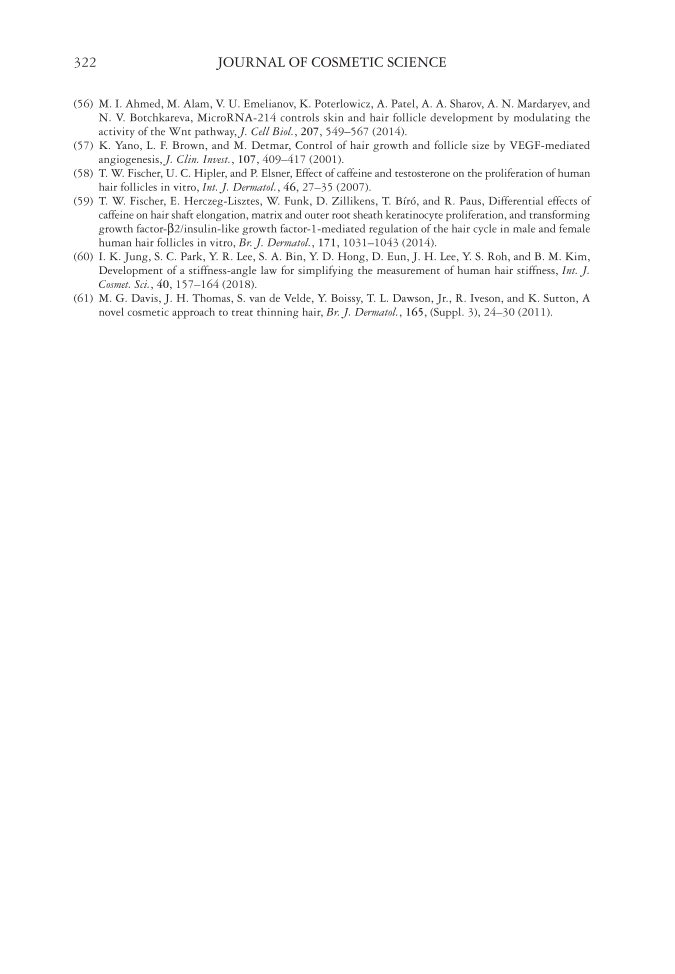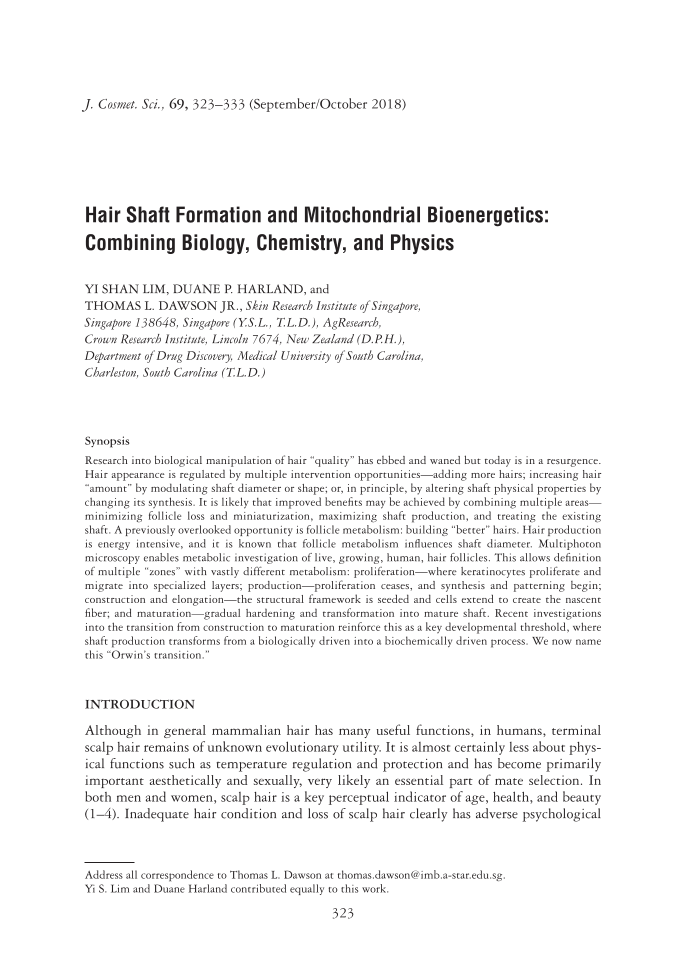JOURNAL OF COSMETIC SCIENCE 322 (56) M. I. Ah med, M. Alam, V. U. Emelianov, K. Poterlowicz, A. Patel, A. A. Sharov, A. N. Mardaryev, and N. V. Botchkareva, MicroRNA-214 controls skin and hair follicle development by modulating the activity of the Wnt pathway, J. Cell Biol., 207, 549–567 (2014). (57) K. Yano, L. F. Brown, and M. Detmar, Control of hair growth and follicle size by VEGF-mediated angiogenesis, J. Clin. Invest., 107, 409–417 (2001). (58) T. W. Fi scher, U. C. Hipler, and P. Elsner, Effect of caffeine and testosterone on the proliferation of human hair follicles in vitro, Int. J. Dermatol., 46, 27–35 (2007). (59) T. W. Fi scher, E. Herczeg-Lisztes, W. Funk, D. Zillikens, T. Bíró, and R. Paus, Differential effects of caffeine on hair shaft elongation, matrix and outer root sheath keratinocyte proliferation, and transforming growth factor-β2/insulin-like growth factor-1-mediated regulation of the hair cycle in male and female human hair follicles in vitro, Br. J. Dermatol., 171, 1031–1043 (2014). (60) I. K. Jung, S. C. Park, Y. R. Lee, S. A. Bin, Y. D. Hong, D. Eun, J. H. Lee, Y. S. Roh, and B. M. Kim, Development of a stiffness-angle law for simplifying the measurement of human hair stiffness, Int. J. Cosmet. Sci., 40, 157–164 (2018). (61) M. G. Davis, J. H. Thomas, S. van de Velde, Y. Boissy, T. L. Dawson, Jr., R. Iveson, and K. Sutton, A novel cosmetic approach to treat thinning hair, Br. J. Dermatol., 165, (Suppl. 3), 24–30 (2011).
J. Cosmet. Sci., 69, 323–333 (September/October 2018) 323 Hair Shaft Formation and Mitochondrial Bioenergetics: Combining Biology, Chemistry, and Physics YI SHAN LIM, DUANE P. HARLAND, and THOMAS L. DAWSON JR., Skin Research Institute of Singapore, Singapore 138648, Singapore (Y.S.L., T.L.D.), AgResearch, Crown Research Institute, Lincoln 7674, New Zealand (D.P.H.), Department of Drug Discovery, Medical University of South Carolina, Charleston, South Carolina (T.L.D.) Synopsis Research into biological manipulation of hair “quality” has ebbed and waned but today is in a resurgence. Hair appearance is regulated by multiple intervention opportunities—adding more hairs increasing hair “amount” by modulating shaft diameter or shape or, in principle, by altering shaft physical properties by changing its synthesis. It is likely that improved benefi ts may be achieved by combining multiple areas— minimizing follicle loss and miniaturization, maximizing shaft production, and treating the existing shaft. A previously overlooked opportunity is follicle metabolism: building “better” hairs. Hair production is energy intensive, and it is known that follicle metabolism infl uences shaft diameter. Multiphoton microscopy enables metabolic investigation of live, growing, human, hair follicles. This allows defi nition of multiple “zones” with vastly different metabolism: proliferation—where keratinocytes proliferate and migrate into specialized layers production—proliferation ceases, and synthesis and patterning begin construction and elongation—the structural framework is seeded and cells extend to create the nascent fi ber and maturation—gradual hardening and transformation into mature shaft. Recent investigations into the transition from construction to maturation reinforce this as a key developmental threshold, where shaft production transforms from a biologically driven into a biochemically driven process. We now name this “Orwin’s transition.” INTRODUCTION Although in general mammalian hair has many useful functions, in humans, terminal scalp hair remains of unknown evolutionary utility. It is almost certainly less about phys- ical functions such as temperature regulation and protection and has become primarily important aesthetically and sexually, very likely an essential part of mate selection. In both men and women, scalp hair is a key perceptual indicator of age, health, and beauty (1–4). Inadequate hair condition and loss of scalp hair clearly has adverse psychological Address all correspondence to Thomas L. Dawson at thomas.dawson@imb.a-star.edu.sg. Yi S. Lim and Duane Harland contributed equally to this work.
Purchased for the exclusive use of nofirst nolast (unknown) From: SCC Media Library & Resource Center (library.scconline.org)









































































































